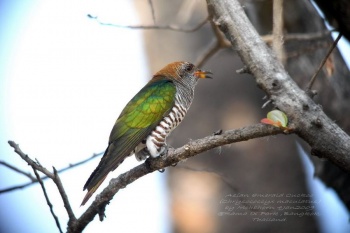(User template) |
(Photo of female. Reference) |
||
| Line 1: | Line 1: | ||
| − | [[Image:Asian_Emerald_Cuckoo.jpg|thumb|550px|right|Male | + | [[Image:Asian_Emerald_Cuckoo.jpg|thumb|550px|right|Male <br />Photo by {{user|Reini|Reini}}<br />[[Doi Inthanon National Park]] km 38, Northern [[Thailand]], November 2006]] |
;[[:Category:Chrysococcyx|Chrysococcyx]] maculatus | ;[[:Category:Chrysococcyx|Chrysococcyx]] maculatus | ||
| − | |||
==Identification== | ==Identification== | ||
Size-18 cm. | Size-18 cm. | ||
| Line 12: | Line 11: | ||
==Distribution== | ==Distribution== | ||
The known breeding range extends from the Hamalayas east to Myanmar, northern Thailand and China; south of this range, sporadic occurances in India, Sri Lanka, South-east Asia, the Malay Peninsula and Sumatra fall mainly during the wintering periods and are therefore assumed to be either non-breeding vistors or vagrants due to the lack of evidence of breeding within this range. | The known breeding range extends from the Hamalayas east to Myanmar, northern Thailand and China; south of this range, sporadic occurances in India, Sri Lanka, South-east Asia, the Malay Peninsula and Sumatra fall mainly during the wintering periods and are therefore assumed to be either non-breeding vistors or vagrants due to the lack of evidence of breeding within this range. | ||
| + | [[Image:Asian Emerald Cuckoo 5.jpg|thumb|350px|right|Female<br />Photo by {{user|mohbhorn|mohbhorn}}<br />[[Rama IX Park]], Bangkok, [[Thailand]], January 2009 ]] | ||
==Taxonomy== | ==Taxonomy== | ||
| − | The species is monotypic. | + | The species is monotypic.<sup>[[#References|[1]]]</sup> |
==Habitat== | ==Habitat== | ||
Forest and forest edges. | Forest and forest edges. | ||
| − | |||
==Behaviour== | ==Behaviour== | ||
Frequents the canopy and crown of tall trees. Other habits little known. | Frequents the canopy and crown of tall trees. Other habits little known. | ||
| − | + | ==References== | |
| + | #{{Ref-Clements6thDec08}} | ||
| + | {{ref}} | ||
==External Links== | ==External Links== | ||
{{GSearch|Chrysococcyx+maculatus}} | {{GSearch|Chrysococcyx+maculatus}} | ||
*[http://www.orientalbirdimages.org/birdimages.php?action=birdspecies&Bird_ID=427&Bird_Image_ID=676&Bird_Family_ID=79 View more images of this species on Orientalbirdimages] | *[http://www.orientalbirdimages.org/birdimages.php?action=birdspecies&Bird_ID=427&Bird_Image_ID=676&Bird_Family_ID=79 View more images of this species on Orientalbirdimages] | ||
[[Category:Birds]] [[Category:Chrysococcyx]] | [[Category:Birds]] [[Category:Chrysococcyx]] | ||
Revision as of 20:03, 4 July 2009
- Chrysococcyx maculatus
Identification
Size-18 cm.
Adult Male: Iridescent dark green head, upper-parts and upper breast together with white lower breast and belly marked with dark green barring diagnostic. Orbital skin orange; bill orange yellow with dark tip.
Sub-adult Male: Similar to adult male but entire underparts (including throat and breast) marked with white and dark green bars.
Female: Pale coppery green upperparts together with chestnut crown and nape diagnostic. Entire underparts barred. In flight both sexes show white band on underwing, at base of flight feathers. Voice a sharp CHWEEK, usualy uttered in flight.
Distribution
The known breeding range extends from the Hamalayas east to Myanmar, northern Thailand and China; south of this range, sporadic occurances in India, Sri Lanka, South-east Asia, the Malay Peninsula and Sumatra fall mainly during the wintering periods and are therefore assumed to be either non-breeding vistors or vagrants due to the lack of evidence of breeding within this range.
Taxonomy
The species is monotypic.[1]
Habitat
Forest and forest edges.
Behaviour
Frequents the canopy and crown of tall trees. Other habits little known.
References
- Clements, JF. 2008. The Clements Checklist of Birds of the World. 6th ed., with updates to December 2008. Ithaca: Cornell Univ. Press. ISBN 978-0801445019.
Recommended Citation
- BirdForum Opus contributors. (2024) Asian Emerald Cuckoo. In: BirdForum, the forum for wild birds and birding. Retrieved 24 April 2024 from https://www.birdforum.net/opus/Asian_Emerald_Cuckoo





